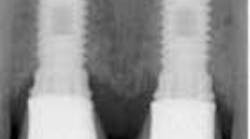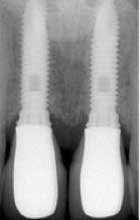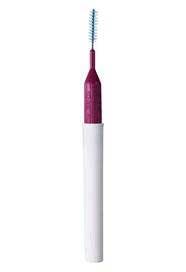Finding evidence based answers does not seem to be too complicated a project, on the surface, but this is a true misunderstanding. In order to find an evidence based answer, we use our own clinical expertise, the patient’s wishes, the tools that are available, and the scientific evidence.
Since dental hygiene and dental care professionals have education and experience, patients have their own ideas, the industry brings us occasional new concepts. In reality, what is the best available evidence?
Pik Pocket Tip, Water Pik, Inc. Fort Collins, CO
But what about the other devices we recommend for our patients to use at home for implant maintenance, such as Super floss, single tufted brushes, dental floss, gauze, conical interdental brushes, and oral irrigators? I am sad to say, there is little scientific evidence to support their use!
How about the concept of evidence based decisions, which we are asked to make these days? We need to be creative with our own clinical expertise, the patient’s wishes, and the available tools and products in the marketplace. This is called best practice! Dental implants are “mimic” teeth. For some time, we have known that we need to probe implants like normal teeth, and there is really no more controversy on this topic. We must establish a baseline with probing depths and radiographs.
Also, professional debridement is similar to what we are used to doing in a natural dentition, although this is an item for research currently being investigated by the PhD project of Anna Louropoulou at ACTA Universtity, the Netherlands. But definitely, home care products need to be a focus of research, especially for dental hygienists!
References
1. Rasperini G, Pellegrini G, Cortella A, Rocchietta I, Consonni D, Simion M. The safety and acceptability of an electric toothbrush on peri-implant mucosa in patients with oral implants in aesthetic areas: a prospective cohort study. Eur J Oral Implantol. 2008 Autumn;1(3):221-8.
2. Vandekerckhove B, Quirynen M, Warren PR, Strate J, van Steenberghe D. The safety and efficacy of a powered toothbrush on soft tissues in patients with implant-supported fixed prostheses. Clin Oral Investig. 2004 Dec;8(4):206-10.
3. Wolff L, Kim A, Nunn M, Bakdash B, Hinrichs J. Effectiveness of a sonic toothbrush in maintenance of dental implants. A prospective study. J Clin Periodontol. 1998 Oct;25(10):821-8.
4. Truhlar RS, Morris HF, Ochi S. The efficacy of a counter-rotational powered toothbrush in the maintenance of endosseous dental implants. J Am Dent Assoc. 2000 Jan;131(1):101-7.
5. Tawse-Smith A, Duncan WJ, Payne AG, Thomson WM, Wennström JL. Relative effectiveness of powered and manual toothbrushes in elderly patients with implant-supported mandibular overdentures. J Clin Periodontol. 2002;29:275-80.
6. Felo A, Shibly O, Ciancio SG, Lauciello FR, Ho A. Effects of subgingival chlorhexidine irrigation on peri-implant maintenance. Am J Dent. 1997 Apr;10(2):107-10.
7. Chongcharoen N, Lulic, M, and Lang NP. Effectiveness of different interdental brushes on cleaning the interproximal surfaces of teeth and implants. Clinical Oral Implants Research, Clinical Oral Implants Research, Volume 23, Issue 5, pages 635–640, May 2012 Article first published online: 6 DEC 2011.
*Water Pik, Inc., Fort Collins, CO









